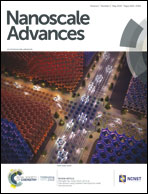Top-down fabrication of ordered arrays of GaN nanowires by selective area sublimation†
Abstract
We demonstrate the top-down fabrication of ordered arrays of GaN nanowires by selective area sublimation of pre-patterned GaN(0001) layers grown by hydride vapor phase epitaxy on Al2O3. Arrays with nanowire diameters and spacings ranging from 50 to 90 nm and 0.1 to 0.7 μm, respectively, are simultaneously produced under identical conditions. The sublimation process, carried out under high vacuum conditions, is analyzed in situ by reflection high-energy electron diffraction and line-of-sight quadrupole mass spectrometry. During the sublimation process, the GaN(0001) surface vanishes, giving way to the formation of semi-polar {1![[1 with combining macron]](https://www.rsc.org/images/entities/char_0031_0304.gif) 03} facets which decompose congruently following an Arrhenius temperature dependence with an activation energy of (3.54 ± 0.07) eV and an exponential prefactor of 1.58 × 1031 atoms per cm2 per s. The analysis of the samples by low-temperature cathodoluminescence spectroscopy reveals that, in contrast to dry etching, the sublimation process does not introduce nonradiative recombination centers at the nanowire sidewalls. This technique is suitable for the top-down fabrication of a variety of ordered nanostructures, and could possibly be extended to other material systems with similar crystallographic properties such as ZnO.
03} facets which decompose congruently following an Arrhenius temperature dependence with an activation energy of (3.54 ± 0.07) eV and an exponential prefactor of 1.58 × 1031 atoms per cm2 per s. The analysis of the samples by low-temperature cathodoluminescence spectroscopy reveals that, in contrast to dry etching, the sublimation process does not introduce nonradiative recombination centers at the nanowire sidewalls. This technique is suitable for the top-down fabrication of a variety of ordered nanostructures, and could possibly be extended to other material systems with similar crystallographic properties such as ZnO.



 Please wait while we load your content...
Please wait while we load your content...